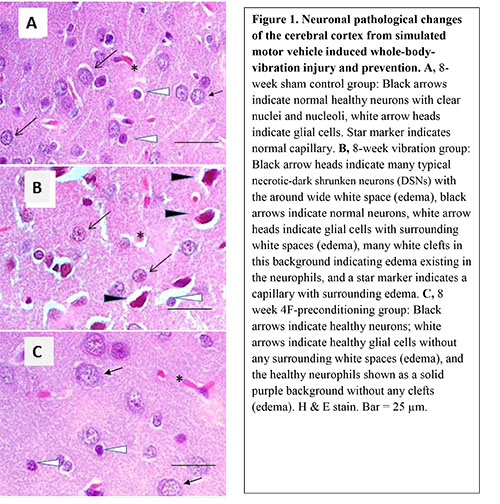


Posted May 22, 2015
Ji-Geng Yan, M.D., Ph.D.; Medical College of Wisconsin
 Military personnel are exposed to various types of vibration on a daily basis through activities such as driving in tanks and other motor vehicles over rough terrain. Acute symptoms of vibration exposure include weakness, fatigue, and decreased judgment. Chronic vibration injury, also known as Hand-Arm Vibration Syndrome, can cause even more severe symptoms such as muscle weakness, permanent nerve damage, and vascular complications (Raynaud's phenomenon). While this syndrome is descriptive of the effects of vibration on the hands/arms, the effects of whole body vibration (WBV) have been less investigated. Dr. Yan and his team conducted a study to investigate the pathological effects of WBV in rats and test the hypothesis that WBV can cause significant neural and vascular injuries. In addition, through the use of the synthetic peptide D-4F, the investigators found a potential means of reducing the potential of physiological damage caused by WBV.
Military personnel are exposed to various types of vibration on a daily basis through activities such as driving in tanks and other motor vehicles over rough terrain. Acute symptoms of vibration exposure include weakness, fatigue, and decreased judgment. Chronic vibration injury, also known as Hand-Arm Vibration Syndrome, can cause even more severe symptoms such as muscle weakness, permanent nerve damage, and vascular complications (Raynaud's phenomenon). While this syndrome is descriptive of the effects of vibration on the hands/arms, the effects of whole body vibration (WBV) have been less investigated. Dr. Yan and his team conducted a study to investigate the pathological effects of WBV in rats and test the hypothesis that WBV can cause significant neural and vascular injuries. In addition, through the use of the synthetic peptide D-4F, the investigators found a potential means of reducing the potential of physiological damage caused by WBV.
Previous studies conducted by Dr. Yan's group at the Medical College of Wisconsin indicated that both peripheral nerve damage and vascular complications occur after 2 weeks of WBV exposure. In this recent study, the researchers examined the effects of WBV exposure to groups of rats (n=8) at 2-, 4-, and 8-week intervals. To do this, Dr. Yan's team developed an animal model of simulated motor vehicle-induced WBV. Unanesthetized rats voluntarily entered PVC tubes that were connected to a vibrating platform set to produce linear oscillations of 30 Hz at 0.5g acceleration. The rats were exposed to the vibration for 4 hours/day, 5 days/week.
Compared to normal controls, rats subjected to vibration performed significantly worse in a variety of tests that judged central and peripheral neural functions. Rats that experienced vibration were slower-moving, exhibited a greater number of errors in a maze test, and had delayed Von Frey sensory times, longer tail flick times, and lower grip force. Furthermore, as the weeks of vibration exposure increased, the rats' performance in each test continued to decline in comparison to the sham controls (rats kept in non-vibrating PVC tubes). Dr. Yan's team also conducted a histological analysis of brain tissue from the rats post-WBV exposure at each week time point. In rats with 8 weeks of vibration exposure, there was a significant increase in the number of dark shrunken neurons as well as increased neuronal atrophy. These results suggest that long-term WBV can cause permanent brain damage and severely impact cognitive function and reactive capabilities.
The investigators also studied the effect of D-4F pretreatment, post-treatment, and co-treatment on WBV in rats. Dr. Yan's group found that WBV exposure creates vascular spasm and endothelium injury, which ultimately leads to a positive feedback loop in which nitrous oxide (NO) and endothelial nitric oxide synthase (eNOS) are depleted, thus decreasing vasodilation and increasing vascular damage. Results from arterial imaging and blood flow volume measurements showed that WBV caused decreased blood flow to the brain, ultimately leading to neuronal trauma and necrosis. Dr. Yan decided to test the conditioning effects of D-4F due to its ability to restore eNOS and NO and reduce inflammation to prevent vascular injury (it is currently also being tested for the prevention of chronic vascular disease). While the most efficacious treatment group varied per test conducted, rats treated with D-4F (pre-, co-, or post-) produced results consistent with the control group results and showed improved function compared to rats exposed to vibration. Overall, the researchers found that D-4F conditioning decreased vasoconstriction and lowered fatigue in the rats.
Dr. Yan's study provides evidence of the substantial neural and vascular damage that can be caused by WBV and offers a vast amount of knowledge for further research. The preventive effect of D-4F can have significant impacts on alleviating chronic symptoms of vibration exposure and ultimately have important implications for optimizing both military and public health.

List of associated publications:
1) Yan JG, Zhang LL, Agresti M, et al. 2015. Prevention of physiological Impairments from whole body vibration by conditioning with 4F ApoA-I mimetic. Journal of Health Science, 2 (2014)441-452.
2) Davis J, Wang Z, Zhang LL, et al. 2014. A quantitative study of vibration injury to peripheral nerves - introducing a new longitudinal section analysis. Hand (N Y) 9(4):413-418. Doi: 10.1007/s11552-014-9668-0.
3) Tobin CA, Wang Z, Zhang LL, et al. 2014. A new computerized morphometric analysis for peripheral nerve study. Journal of Reconstructive Microsurgery 30(2):75-82. Doi: http://dx.doi.org/10.1055/s-0033-1354738.
4) Yan JG, Zhang LL, Agresti M, et al. 2014. Neural systemic impairment from whole-body vibration. Journal of Neuroscience Research, 2015 May; 93(5):736-44. Doi:10.1002/jnr.23536. Epub 2014 Dec 29. PMID 25557339.














